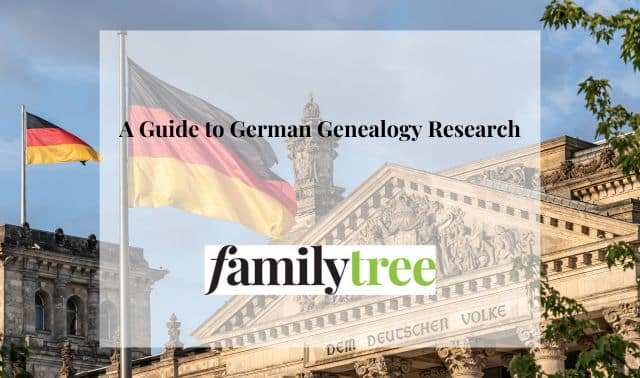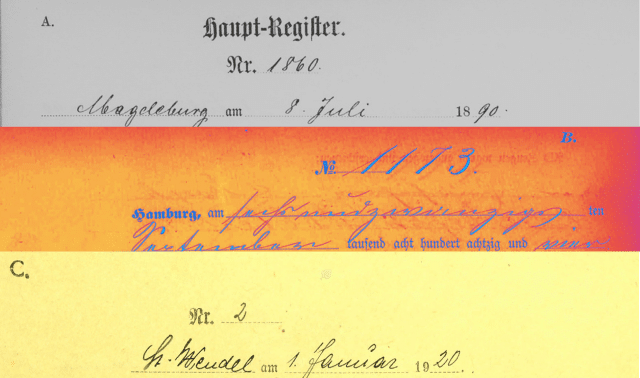Sign up for the Family Tree Newsletter! Plus, you’ll receive our 10 Essential Genealogy Research Forms PDF as a special thank you.
Get Your Free Genealogy Forms
"*" indicates required fields

Most German commoners acquired their surnames in the Middle Ages, sometime around the 1300s, and for most areas (with the conspicuous exceptions noted later in this section) those surnames were fixed from one generation to another, disturbed only by variations in phonetics. Most of the surnames adopted came from occupations, geography, characteristics or patronymics.
Occupational Surnames
Occupational names, most of which are distinguished by the endings –er or –mann, are very common in German and therefore are often more difficult to trace (the joke among German genealogists is that everyone has at least one “Johannes Mueller”/John Miller ancestor). A few examples of this type of surname are Schneider (tailor), Schmidt (smith) or Fenstermacher (window maker).
Geographic Surnames
Geographic names can be fairly specific or general. A Marburger probably has an ancestor who was living in the German city of Marburg when surnames were adopted. A Schweitzer either was living in or a descendant of a family from Switzerland. Dieffenbach simply means “deep creek,” of which there are many in Germany.
ADVERTISEMENT
Characteristic Surnames
Characteristic names run the gamut from presumably complimentary to, well, not so complimentary. They include names such as Lang (long), Schwartzkopf (black head), Weiss (white), Klein (short), Altmann (old man) and Dick (fat).
Patronymic Surnames
Many Germans have patronymic names–surnames derived by combining the father’s given name with some form of Sohn (the German word for “son”). Examples are Hansen and Jacobsohn. Some areas of Germany used changing patronymic surnames into the nineteenth century. This means the surname could change with each generation as the children of the new generation took the name of their father as their surnames. For example, Jacob’s son, Robert, has the surname Jacobsohn and Robert’s son, Johannes, has the surname Robertsohn, even though Robert’s surname is Jacobsohn. The areas that used changing patronymic surnames were Ostfriesland and Schleswig-Holstein, which is not surprising because these are the areas of Germany closest to Scandinavia, where patronymics also survived into the 1800s.
Another complication to be aware of are so-called Hofname (translated as either “farm names” or “house names”). This happened most often when a farm owner’s daughter inherited the land and her husband took on the farm name as his own. Children born prior to the inheritance were baptized under the father’s original surname, then changed their names later; those born after the inheritance used the farm name from birth. The Hofname surnames were most common in the border area between the German states of Niedersachsen (Lower Saxony) and Nordrhein-Westfalen (North Rhine-Westphalia) though they’ve been found in other place, too.
ADVERTISEMENT
Spelling and Evolution of German Surnames
Many German surnames had Umlauts that affected the pronunciation of vowels in ways that confused English-speaking record keepers. The spellings found in documents from the mid-1700s through the nineteenth century are filled with attempts at reconciling German phonetics with English spelling rules, which results in several “standardized” spellings for descendants today.
A Swiss-German name that was usually spelled in Europe as Schürch and was pronounced roughly as “Shoo-air-k” evolved in the following way:
| Original Spelling in Europe | Early American Variants | Modern-Day Common Spellings |
| Schürch | Scherrick | Shirk |
| Schuerch | Sherrick | Sherk |
| Tsherrk | Sherick | |
| Shurrick | ||
| Scherich | ||
| Shurg | ||
| Scheerg | ||
| Sherrig | ||
| Schurck |
Vowels
Vowels with Umlauts (shown as a pair of dots written over a, o, u and y; it takes the place of an e) are responsible for many spelling variations. Here are a few examples for illustrations:
- The German vowel a is most often pronounced as an English “short” a, but when Umlauted, it is said more like a “long” a sound. This creates additional confusion because the German vowel e (as a single vowel) also is pronounced like an English “long” a.
- A German vowel u is ordinarily pronounced as an English “long” u, but when an Umlaut is added, it becomes a difficult-to-render-in-English cross between a “long” u and a “long” e. Many German names with Umlauted u‘s came to be spelled with an i, ie or ee (and pronounced either with a “short” i or “long” e sound).
In cases of vowel combinations that did not include Umlauts, it was generally the second letter of the vowel combination that “spoke”; for example:
- ie, pronounced as a “long” e
- ei, pronounced with a “long” i
- eu, pronounced as a “long” u
Because of these pronunciations, a speller unacquainted with German phonetics would reverse the letters when writing out the name. In addition, persons of Jewish origin with such German names usually pronounced their names by using the sound of the first vowel.
Consonants
In German, a number of consonants are either pronounced differently than in English or can be confused unless heard distinctly. Some examples include:
- b and p
- d and t and th
- g and k and c
- the German w is pronounced like an English v
- the German v is pronounced like an English f
- the German v and f can be interchangeable
- the German s (especially one beginning a word) is pronounced more like an English z
- the German z is pronounced like an English ts
- the sch found in many German words is pronounced as sh in English
ADVERTISEMENT




